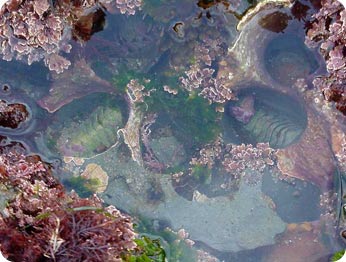For the young -- and the young at heart -- the highlight of many a trip to the coast is a visit to a tide pool. Each little universe of life might hold starfish, crabs, shrimp, sponges, or many other colorful species. Birds and mammals wade in to grab lunch, while a coating of algae makes the whole thing as slippery as an ice-skating rink.
 Many organisms live in tide pools. Credit: JDPhoto.org
Many organisms live in tide pools. Credit: JDPhoto.orgTide pools form in basins carved into rocky shorelines by wind and waves. When the tide rolls in, they’re covered in water. When it rolls out, they’re cut off from the open ocean. Any organism that’s inside must hold on until the tide returns.
For many, that’s not a bad deal. The tide brings plenty of food, and the basins provide great surfaces for clinging to, or rocks for hiding under.
Many organisms live in these pools all the time. Clams and other mollusks, for example, aren’t very mobile. They can live off the algae that line the rocky surface, or tiny creatures that move in and out with the tides. If the pools begin to dry up, they close their shells and wait for water to return.
Other creatures are just visiting the tide pools -- like shrimp. When the tide is high, they may paddle in to feast on the algae. When the tide retreats, they get trapped. But if they don’t get eaten by something else, they can return to the ocean at the next high tide.
Chains of tide pools are like buffet lines for marine mammals, like walruses and sea lions, and land-based creatures, such as foxes. So these rocky basins are important oases of life for both sea and land.

